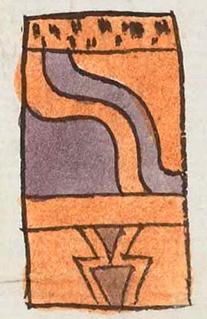Tehuehuec (Mdz28r)
This simplex glyph of a drum (huehuetl) also stands for the place name Tehuehuec. It is an upright drum, made of wood (note the terracotta and purple colors, which are also used for earth and stone). The top has a jaguar skin covering. The bottom has stepped-shape cutouts, which provide the (typically three) legs for the drum. The locative suffix (-c) is not shown visually.
Stephanie Wood
This percussion instrument could be struck with the human hand or with a mallet. Here is a website that provides considerable information about the drum, including photographs of surviving huehuetl and images from codices.
Stephanie Wood
tehuehuec. puo
Tehuehuec, pueblo
Stephanie Wood
c. 1541, or by 1553 at the latest
Stephanie Wood
nombres de lugares

huehue(tl), upright drum, https://nahuatl.wired-humanities.org/content/huehuetl
el atabal
Alonso de Molina
Codex Mendoza, folio 28 recto, https://digital.bodleian.ox.ac.uk/objects/2fea788e-2aa2-4f08-b6d9-648c00..., image 66 of 188.
The Bodleian Libraries, University of Oxford, hold the original manuscript, the MS. Arch. Selden. A. 1. This image is published here under the UK Creative Commons, “Attribution-NonCommercial-ShareAlike 3.0 License” (CC-BY-NC-SA 3.0).







